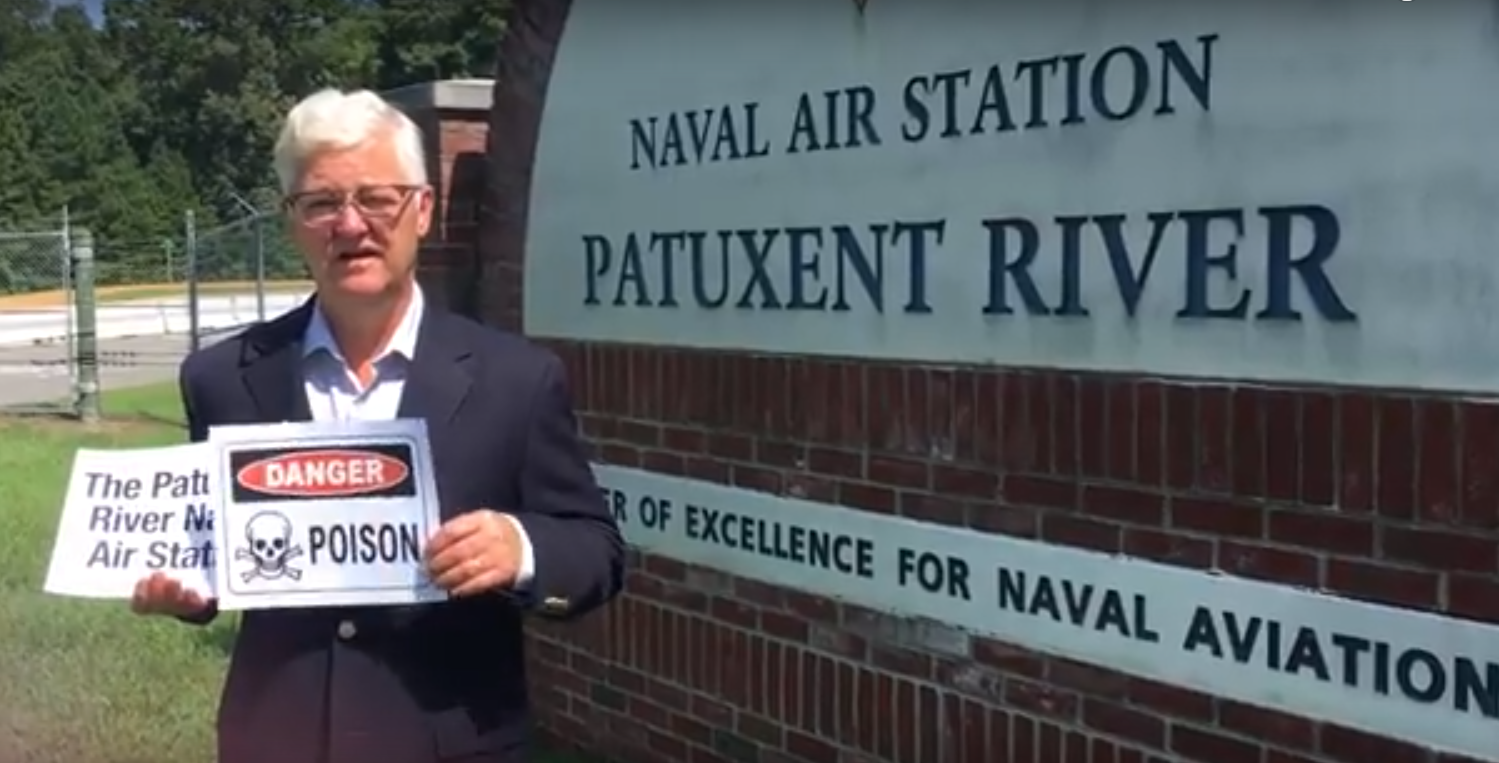
The author on the banks of the Patuxent.
Dangerous Levels of PFAS Found in the
Little Patuxent River at Fort George G. Meade
Pat Elder / Military Poisons
MARYLAND (November 22, 2021) — in the last few months, I’ve tested surface water for PFAS that flows out of the Navy’s Research Lab in Chesapeake Beach, (6,058 parts per trillion, ppt), the Air Force’s Joint Base Andrews, in Clinton, (2,781 ppt), and now, the Army’s Fort George G. Meade in Laurel, (2,306.2 ppt). The Navy, Air Force, and the Army are contaminating Maryland’s rivers with these powerful chemicals.
When the U.S. Constitution was framed it wasn’t intended to be this way. The United States Government does not have the right to poison the waters near me in the St. Mary’s River, the Potomac River, and the Chesapeake Bay — and it does not have the right to contaminate the waters of Laurel, Clinton, and Chesapeake Beach — or in other parts of the state.
The recent test sampled water in the Little Patuxent River that flows past Fort Meade and the NSA. Most of the PFAS (per-and poly fluoroalkyl substances) found in the river is from PFOS (Perfluorooctane sulfonic acid), an extraordinarily lethal variety of the carcinogens. This is frightening, although it still doesn’t mean much to most folks, due to the general lack of media coverage, especially concerning the contamination of surface waters coming from military installations. This report, for instance, won’t be picked up by the mainstream press, although they read it.
The Europeans are regulating these chemicals when they reach .65 ppt in surface waters. Some states have begun issuing warnings when PFOS reaches double digits in the water. Wisconsin, for instance, limits fish consumption when waters top 12 ppt of PFOS and PFOA together, while Maryland plays games with public health.
Maryland recently issued a farcical advisory for a few species of fish in Piscataway Creek near Joint Base Andrews. Apparently, the state felt pressured to do something after being hounded. The Maryland Department of the Environment (MDE) reported total levels of PFAS from 207 ppt to 3,193 ppt in the creek. In response, MDE recommends that adults and children should consume no more than 1 meal per month of Redbreast Sunfish from Piscataway Creek. A Redbreast Sunfish from the creek was found to contain 359,000 ppt of PFOS alone.
An 8-ounce serving of the fish with 359,000 parts per trillion of PFOS contains 81,493 nanograms of the carcinogens. (359 ng/g x 227 g = 81,493 nanograms) A pregnant woman may consume nearly a quarter million nanograms of PFOS in her first trimester.
Maryland’s Department of Health is silent.
No one should be eating any fish from that creek! Sadly, this holds true for many of Maryland’s waterways. The EPA now says these chemicals are far more dangerous than previously thought, although the agency does not regulate them.

The state of Maryland gives American Water
permission to contaminate the Little Patuxent River.
Governor Hogan, Secretary Grumbles, and American Water’s General Manager Cole likely understand the magnitude of this problem. They’re not being responsible stewards of the environment. They can say the EPA doesn’t consider PFAS to be hazardous substances, so everything is fair game, but women who are pregnant or may become pregnant ought to be warned their progeny is threatened for eternity when they consume these chemicals in food and water.
It’s time for the state to be honest with us.
According to the MDE, the stream where the treatment plant discharges water at Fort Meade is categorized as an impaired water body due to Calcium, Total Phosphorus, Total Suspended Solids, Sedimentation/Siltation, PCBs in fish tissue, Mercury in fish tissue, E Coli, and Chloride. PFAS isn’t mentioned – and it’s regarded as among the worst of all pollutants because it never goes away and it wildly bioaccumulates in aquatic life, wildlife, and humans.
.jpg)
The white circle shows the Fort Meade Wastewater Treatment Plant.
The blue x shows the testing location in the Little Patuxent.
The red X marks the location of the former fire training area.
We learned a lesson this year from the way the Navy’s wastewater treatment plant affected PFAS levels in a stream at the Naval Research Laboratory — Chesapeake Bay Detachment. As the stream travels away from the historic fire training area on the base in Calvert County, PFAS levels predictably decrease – from levels in the thousands to 224 ppt. The Navy reports, however, that PFAS levels in the stream jump six-fold from 224 ppt to 1,476 ppt as the stream passes by the treatment plant before discharging into the Chesapeake Bay about 1,000 feet away.
Military Poisons tested the stream where it entered the Chesapeake Bay and recorded 6,058 ppt of total PFAS.
The Navy has assured us that PFAS in their current fire-fighting foam experiments is completely contained at Chesapeake Beach. The spike in PFAS concentrations shows the contamination is coming from sewer drains from one or more buildings on base.
Wastewater treatment plants don’t treat for PFAS. They don’t have to, and that’s because the EPA is criminally negligent. Federal, military, and state authorities in Maryland understand this. Violations involving other contaminants have been identified at the Fort Meade plant for the last 12 consecutive quarters, according to Enforcement and Compliance History Online, (ECHO).
Notice how American Water Military Services addresses PFOA and PFOS in drinking water at Fort Meade in their 2020 Annual Water Quality Report. They say the carcinogens are not detected, although they’re using “parts per billion” as their testing parameter. The water could contain concentrations of up to 1,000 parts per trillion and we wouldn’t know it from this report.
The state of Maryland played the same trick when they tested for PFAS in oysters at the mouth of the Patuxent River. They failed to report concentrations under 1,000 parts per trillion for the multiple compounds tested.

Spill of PFAS fire-fighting foam threatens river.
The study concluded that PFAS is present in the Patuxent River oysters “at concentrations significantly below risk based recreational use screening criteria and oyster consumption site-specific screening criteria.” It sounds convincing, but eating the oysters, like eating the catfish, likely entails consuming concentrations of thousands of nanograms of the toxins.
Groundwater sampling by the DOD in 2017 showed 87,000 ppt of PFOS/PFOA at Fort Meade. These are routine concentrations at military installations around the world.
Figuring out how to test surface water for the highest possible results at military bases is not rocket science. You just have to locate the surface waters as they flow off base and then examine google maps for nearby wastewater treatment plants. You can also look through engineer’s reports to ascertain the locations of historic fire training areas and or landfills close to the rivers. Fort Meade has three inactive landfills close to the Little Patuxent River.
You can do this, although the mainstream media is unlikely to cover your story. Running it would make enemies and it wouldn’t help their bottom line.
Thank you for the donations to pay for testing! Please contribute to help defray the cost of testing across the country.